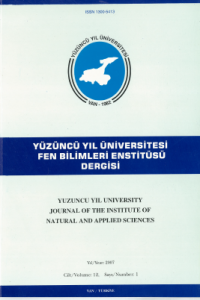lnvestigation on the Relationship Between Resistance to Verticillium Wilt and Solavetivone Accumulation in Callus Culture of Eggplants
Abstract
Verticillium dahliae fungus was isolated from diseased plants of greenhouses in Antalya and infected to Long Purple eggplant variety and Solanum sisymbriifolium seedlings susceptible to this disease and pathogenity test was carried out. While the wild plant varieties have not exhibited disease symptoms, fungus was found to be 60.7% pathogen for susceptible varieties. Solavetivone phytoalexin was formed within callus tissues over which three different doses of V.dahliae fungal elicitor were applied. Measurements carried out 24, 48 and 72 hours after elicitor application showed that the highest solavetivone accumulation was observed in callus of wild variety with '2.0 mi elicitor + 72 hour elicitation duratlon' combination. An opinion has grown aut that there might be a relation between solavetivone accumulation in callus tissues and resistance to V.dahliae.
References
- Kaynakça verildi.
Patlıcanda Verticillium Solgunluğuna Dayanıklılık ile Kallus Kültüründe Solavetivon Birikimi Arasındaki İlişkinin İncelenmesi
Abstract
Antalya'daki seralardan toplanan hastalıklı bitkilerden izole edilen Verticillium dahliae fungusu, bu hastalığa duyarlı Long Purple patlıcan çeşidi ile Solanum sisymbriifolium fidelerine bulaştırılmış ve patojenite testi yapılmıştır. Yabani türe ait bitkiler hastalık belirtisi göstermemiş, duyarlı çeşitte ise fungusun neden olduğu hastalık şiddeti %60.7 oranında belirlenmiştir. V.dahliae fungal elisitörünün üç farklı dozu uygulanan kallus dokularında solavetivon fitoaleksini oluşmuştur. Elisitör uygulamasından 24, 48 ve 72 saat sonra yapılan ölçümlerde en yüksek solavetivon birikimi yabani türün kalluslarında, '2.0 ml elisitör + 72 saat uyarı süresi' kombinasyonundan elde edilmiştir. Kallus dokusunda solavetivon birikimi ile V.dahliae' ye dayanıklılık arasında bir ilişkinin bulunabileceği yönünde bir görüş oluşmuştur.
References
- Kaynakça verildi.
Details
| Primary Language | Turkish |
|---|---|
| Journal Section | Articles |
| Authors | |
| Publication Date | January 1, 2007 |
| Submission Date | January 1, 2007 |
| Published in Issue | Year 2007 Volume: 12 Issue: 1 |


